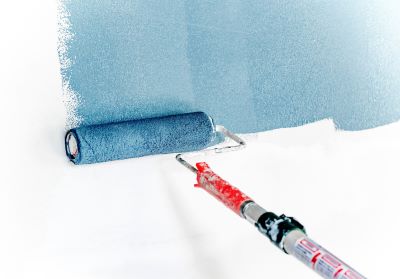
A lot of confusion stems from which paints and primers work together. Most of this confusion comes from issues with water-based and oil-based combinations. Also, many people believe oil-based paints do not mix well with other paints. That being said, you can use latex paint over oil-based primer without issues. What you cannot do is use oil-based paints over latex paint.
Now that we have the short answer let’s look at facts to help you make better paint decisions.
Latex Paint
Latex is a form of rubber, and latex paint is basically a liquid rubber paint with a matte finish. Latex paint comes in three varieties, including acrylic, vinyl-acrylic, and alkyd-modified latex. Full acrylic paint works the best as it adheres well and keeps its color. However, vinyl-acrylic cot lest and works well indoors, while alkyd-modified latex works best outside.
Oil-Based Primer
Primer acts as a glossy pre-coat to even out a surface and gets it ready for painting. Oil-based primers are the most popular but come with noxious scents. They offer increase versatility with a variety of surfaces and work well with oil paints and latex paints. Moreover, you can use them on interior or exterior surfaces as long as the surface is unfinished.
Oil paints do not mix because they take a very long time to dry compared to acrylic or latex paints. For this reason, you should avoid using oil-based paint over latex paint unless you want cracked paint, as the two layers will dry at different rates. Using latex paint over oil-based primer can be done, but it’s a bit of a tricky process; however, it’s worth it for the end result.
When You Should Use Latex Paint Over Oil-Based Primer
Latex paint works best over a primed surface to prevent cracks or the paint not sticking properly. When done over oil-based primer, you can have a long-lasting and solid surface. Here are the steps you need to follow to do the job correctly:
- Lightly sand the surface. Use fine sandpaper such as 180 to 220 grit. This will remove the gloss from the primer and help the paint to stick.
- Clean the surface with TSP (trisodium phosphate) and water on a sponge.
- Use a clean sponge and clean water to remove all of the cleaners. Now let the surface dry.
- Apply a coat of the oil-based primer and allow it to dry completely, which will take about 8 to 16 hours depending on how heavy a coat of paint you use.
- Add one or two coats of latex paint and let it dry.
Reasons to Use Latex Paint Over Oil-Based Primer
An oil-based primer is often more effective and efficient than a latex primer. You should use latex paint over oil-based primer on varnished or unfinished wood, redwood, cedar, painting over damaged paint, weathered wood, and damp rooms like a bathroom. Oil-based primers prevent wood from producing tannins and bleeding to the surface of latex paints, making them a particularly effective combo.
Furthermore, oil-based primers on unfinished surfaces allow for a proper seal that provides latex paint to cover the surface better. Keep in mind, though, that latex paint swells the grains of wood, but with the oil-based primer on first, you can prevent the wood from swelling and end with a smooth, lasting finish.
Different Types of Primers
Primer comes in a variety of different materials. Each has a different benefit. Let’s take a look at the different options and how they work with other paints.
Oil-Based
Oil-based primers work well with oil and latex paints as it’s very versatile. Also, you can use it inside and outside and prevent peeling, cracking, and blistering for a long time. However, oil-based paint dries slowly and release VOCs (volatile organic compounds) that can cause harm with long exposure or high concentrations. It’s worth it for the long-lasting finish. Please remember to wear protective gear when using oil-based products and during the cleaning, too, as you will need to use thinners and solvents to clean up the mess.
Latex-Based
Most often, latex-based primers are used over drywall as it dries quickly in about three to four hours. It can also be used on brick, concrete, and galvanized metals. Latex-based prime works can cover stains like smoke or crayons, but oil and shellac options work better.
Next, it’s water-soluble, making it easier to clean and much healthier for your nose as it has no VOCs. It’s also known as an acrylic primer and works well in damp settings or woods that hold dampness. Finally, latex does not blister, flake, peel, or yellow for a long period of time.
Shellac
Shellac has been around for centuries and is the best at dealing with stains like water, rust, or smoke, and it’s a great sealant that stops tannins from bleeding through the paint. It’s very elastic, too, making it a great primer on plaster, metal, and plastic. Moreover, shellac dries in only an hour but does not clean up as easily. You will need denatured alcohol to thin the primer and to clean tools. Shellac also has a strong smell, and it’s not as versatile as latex or oil-based primers.
How to Tell Oil from Latex
Oil paint is smooth and glossy, while latex is matte and rubbery. If this does not help you to figure it out, grab a cotton ball with acetone and try it in an inconspicuous spot. Latex paint dissolves, but oil paint will not budge.
Final Thoughts
Yes, you can use latex paint over oil-based primer, and you should! The combination provides a strong and durable finish ready to protect your surface. You do need to follow a few key steps to ensure a proper finish. Once you are done, you will be happy you chose this combination.